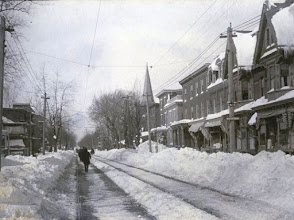This winter/s evil-doers -- mT air masses from the ern PAC -- were overthrown last week when the PV made its long-awaited return home to nrn CN. Since then...LR progs have been honking about more regime change late next week...evidenced by NAO and AO forecasts going negative -- NAO strongly so -- and the PNA flirting with +1.
Do these expected changes in three important winter teleconnection indices portend big snows for the NE and M-A toward the end of the upcoming week?
For the answer to that musical question...we look to Ms. Heather Archambault (University at Albany...State University of New York) who co-authored a study in 2004 titled
'Cool-Season Regime Transition and its Impact on Northeast Precipitation' (PPT).
The study/s premise was to examine...
1) the meteorological wisdom that holds there/s an increased threat of a major storm during large–scale regime transition...
2) past research pointing to a connection between synoptic-scale cyclogenesis and reconfiguration of the planetary-scale flow (e.g. Colucci 1985)...and
3) Dave Groenert (CSTAR...2002) documentation of an apparent tendency for increased precipitation in the Northeast during phase transitions of the North Atlantic Oscillation (NAO).
The study took a statistical look at cool-season (Nov – Apr) weather regime transitions and Northeast precipitation anomalies and created a composite analysis for one kind of regime transition. The regimes were defined as +/- NAO and +/- PNA. Study cases were selected if the index anomaly was at least one standard deviation (STD) from the mean.
Regime change was defined as...
1) a significant change in teleconnection index magnitude (2 stdev) over a 7 – day period...
2) teleconnection index phase change...and
3) index at start of transition must be strongly positive or negative (Index>1 stdev).
Bottom line result of the study -- significant changes in LR forecasts for NAO and PNA would give forecasters a one-week advance 'heads up' of an increased potential for major winter storms.
Are Forecaster's Getting Their Heads Up?No doubt these/s a large scale regime transition going on in across the NHEMI. Geo-potential heights are expected to dramatically rise / fall over Greenland / Azores this week. +PNA is on the way...too.
Will It Be Enough?At the start of the seven-day run-up period...today/s NAO is -0.37 (slightly below the mean) and forecast to fall to ~ -1.5 STD below the mean...which is not even close to the study/s -2.0 STD threshold. It/s worth noting the study did not indicate whether a
sensitivity analysis was done to determine whether a range of slightly higher or lower NAO values altered the final results. It/s possible the STD constraint is too strict and a smaller deviation from the mean...such as -1.5 STD... would sustain the study/s main conclusions.

Like the NAO...the PNA starts out near the mean (0.3) as well. It/s forecast to increase to a smidge more than 1 STD above the mean and like the NAO...the increase in PNA does not meet Archambault/s 2 STD criterion.
 Is A Big One A'comin'?
Is A Big One A'comin'?One huge assumption about MR forecasting of significant NE snowstorm lurks beneath the conclusions of 'Cool-Season Regime Transition and its Impact on Northeast Precipitation.' Can MR / LR NWP models accurately predict the state of the NAO and PNA such that the study/s findings can be put to use in an operational environment or do they merely make for interesting post-mortem analysis?
Two measures of skill are the
'correlation coefficient' (R) and its square...the
'coefficient of determination' (R²). R establishes whether there/a a relationship between the forecast and the observed. Does the observed value increase when the forecast indicates an increase? The closer to one the ratio is...the stronger the relationship. The NAO/s (PNA) seven-day forecast correlation co-efficient is ~0.83 (~0.88)...which is a good indicator that when the forecast indicates a change in direction of the index...it will be correct. The model/s ability to capture the variability (as in variance) of the index is measured by R². R² is the square of the correlation co-efficient. The NAO/s (PNA) R² is 69% (77%) ...meaning 69% (77%) of the variability in the observed NAO (PNA) is captured by the model. Respectable values...but not overly so.
If Archambault et. al./s results are applied to next week/s expected evolution of events along the EC...then nothing 'big' is apt to occur and we/re left waiting and still wanting for the start of some serious winter wx.































 NAO
NAO AO
AO




 Contest storms were 50% more likely when the PNA was greater than zero; however...when a Contest storm occurred...the storms during a -PNA regime were almost as likely as the +PNA regime storms to produce a max station snowfall about of at least 12" and 20".
Contest storms were 50% more likely when the PNA was greater than zero; however...when a Contest storm occurred...the storms during a -PNA regime were almost as likely as the +PNA regime storms to produce a max station snowfall about of at least 12" and 20". There/s a 57% chance that a Contest snowstorm occurs when the AO is negative. When the AO is negative...there/s a 20% chance of one station measuring at least one foot of snow and a 7% chance of a measurement of at least 20".
There/s a 57% chance that a Contest snowstorm occurs when the AO is negative. When the AO is negative...there/s a 20% chance of one station measuring at least one foot of snow and a 7% chance of a measurement of at least 20".






























